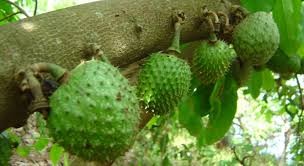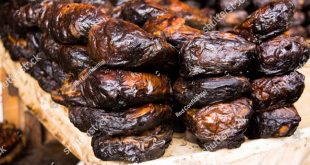
Humanity has been blessed by nature with numerous life rejuvenating and health giving fruits. Among these include the soursop, a fruit that can be rightly regarded as a multipurpose fruit owing to its immense usefulness. It is a powerhouse of nutrients, including vitamin C, vitamin B and a number of antioxidant compounds.
Soursop, also known as graviola, is an oblong tropical fruit with a white, fleshy edible interior and green spiky exterior. The soursop tree is an evergreen that can reach to about 30ft and needs plenty of space, sunlight and warmth.
Owing to its immense health and nutritional benefits, this fruit is the toast of health buffs who can give anything to get it but availability is a challenge. Presently, the fruit is hardly being cultivated on a commercial level, which makes it difficult and expensive to get. One sizeable soursop in the open market can go for as much as N500 or more.
This, therefore, informs this write up geared towards arousing the interest of agriculture stakeholders and lovers of farming to invest in soursop cultivation on a commercial level and tap into its tremendous economic potential. The soursop tree can thrive in any tropical region of the world including Nigeria.

Health benefits of soursop: There are several health benefits that endear soursop to its lovers, which include that it:
Controls parasites
The anti-parasitic nature of soursop has made it a popular treatment in many of rural areas where parasitic infections are common. By brewing a tea from the leaves of the fruit, the gut can be cleansed to ensure that the gastrointestinal system is running smoothly. This benefit is confirmed by a study published in the International Journal of Molecular Sciences.
Anti-inflammatory properties
The anti-inflammatory compounds found in soursop can remedy joint pain or inflammation arising from conditions like gout or arthritis because of its ability to inhibit uric acid, the main cause of gout. Rubbing a decoction of soursop on the affected area can relieve pain, while also improving flexibility. Soursop leaves can also be used to treat arthritis and rheumatic diseases that often occur in elderly people, causing great pain.
Relieves respiratory distress
Soursop’s anti-inflammatory properties can help clear out the airways, relieve congestion and soothe irritation when suffering from cough, cold or other forms of respiratory ailment. Acting partially as an expectorant, soursop eliminates phlegm and mucus, where many pathogens can live.
Skin care
The seeds of the soursop fruit can be pulverised (ground into powder), and formulated into a skin astringent, helping to reduce lines and wrinkles, and improving the appearance of age spots and blemishes. It also protects the skin from bacterial and microbial infections.
Prevents/fights cancer
The most interesting benefit of soursop is related to its antioxidant activity, which comes from acetogenins as well as quinolones and alkaloids. These have been directly linked to cancer prevention and a reduction in the size of tumours. They can cut off blood flow to foreign or non-normal cellular growths, and have already been positively associated with treating breast, pancreatic, prostate, and lung cancers.
A study has shown that the leaves of the soursop plant are more potent than its fruits and seeds against the spread of breast cancer cells and can treat cancer more effectively than chemotherapy that sometimes results in some side effects, not to mention being expensive.
Boosts immunity
Protecting the immune system is one of the benefits of soursop. Rich in vitamin C, this fruit stimulates the production of white blood cells, while the concentration of antioxidants helps to neutralise free radicals and prevent chronic diseases.
Improves gastrointestinal health
Being rich in vitamin C, soursop was used for many years as a natural remedy for scurvy and dysentery. The juice of the soursop fruit can also cleanse the gastrointestinal tract and remove excess toxins and salts from the body. Its antioxidant and anti-inflammatory components can reduce parasites in the gut and alleviate pain or irritation in the stomach or colon. Soursop strengthens the mucus linings of internal organs, which helps to decrease inflammation and reduce the effect of hydrochloric acid in the stomach.
Analgesic properties
Soursop has been topically applied to wounds and injuries for generations but also works internally to relieve pain and speed up healing. The sedative and anti-inflammatory aspects of this fruit make it an ideal solution for all types of body pain, both inside and out.
Prevents heart/nerve diseases
Preventing the risks of heart and nerve disease is another health benefit of soursop. The plant can boost metabolism, stimulate proper blood circulation, and prevent damages to the nerves, thus enabling the heart and nervous system to function better even as one gets older.
Treats diabetes
Soursop leaves contain beneficial ingredients that stabilise blood sugar levels. Extracts of soursop leaves are said to be used as a natural remedy for diabetes.
Prevents osteoporosis
The fruit contains lots of calcium and phosphorous that help to strengthen bones and prevent joint diseases such as osteoporosis.
Eye health
Soursop fruit contains high levels of antioxidants, which help reduce oxidative load in the body. It contains vitamin A, vitamin C, vitamin E, zinc and natural carotenoid compounds. These preserve the health of the eyes and help ensure healthy vision and also thwarts macular degeneration, cataract development, and promotes optimal eye function.
Natural sleep aid
One cup of soursop tea before bed can be a potent natural remedy for a restful night’s sleep. Many individuals who suffer from sleep challenges such as insomnia, may benefit from soursop tea. It provides a calming, stress-relieving effect to the body.
Soursop cultivation
Climate
Soursop is found mostly in tropical climates, and therefore needs a warm environment. It is affected by very high or low temperature. Soursop seeds germinate within two to four weeks of planting. Use the variety that produces big fruits. Go for hybrid soursop seed, which can resist pest and diseases, matures faster (three years), produces big and plenty fruits, etc. Buy the seeds from established seed companies. There are two varieties; the sweet soursop which is mostly for eating and the sour variety which is for processing.
Planting
Soak the seeds in warm water overnight. The next day, plant them half inch deep in sterile seed-starting mix. Keep the soil constantly moist by spraying it with water. It should germinate within two to four weeks. If you are planting outdoors, it’s best to wait until the tree is at least six months old.
Once the seeds have germinated, ensure they are kept in a partially sunny location, a well drained soil, and protected from strong winds. Keep at least 20ft distance from other trees or plants and mulch heavily with compost as soursop has shallow roots.
Maintaining soursop tree
Feed the tree twice a year, once in the wake of rainy season (between March and April) and once in the dry season (between October and November). Give it 1/4 pound of organic fertiliser twice a year in the first year. In its second year and thereafter, feed it 1/2 pound of organic fertiliser twice a year. It is also recommended to renew the compost every year to keep the soil moist and get rid of weeds. During the tree’s second year, cut back the central leader by about a third. Then wait for new shoots to begin beneath the cut, choose the best of these shoots and force them outward. This will create a second tier of horizontal branches (as described above).
The soursop tree’s yellow blossoms should give away within three to five years. Although it may seem like a long time, be patient as it is absolutely worth it, because once it starts flowering, it will keep on going constantly. Space soursop 4mx4m – 7mx7m in rectangular, square or triangular form. Plant between 205-630 in square pattern, 235-720 in triangular pattern. Prepare the planting layout plan before cultivating the seedlings. This will help to determine the number of seedlings it can accommodate. Dig a hole 50cm wide and 50cm deep; put the seedling inside the hole and cover with the top soil. Apply water immediately after planting.
Prune the soursop plants. It will allow free movement of air in the farm, good light penetration, straight and neat branches, etc. Intercrop with crops that can be harvested fast or within a year, for example, cassava, vegetables, maize, etc. It will help in suppressing weeds as well as provide capital, when sold, for the maintenance of soursop plantation until harvest.
Weeding/mulching
The crops should not be left to compete with weeds because it will result in stunted growth and unhealthy plants. Weed twice or thrice a year with machines or manually by the use of hoe or cutlass. A good number of labourers can be paid to do the weeding.
Pest/disease control
Common pests are root grubs, carpenter moth larva, oriental fruit fly and mealy bugs, among others, while common diseases are root rot, anthracnose, pink disease, etc. Burn diseased plant parts, remove fallen fruits and use chemical or neem oil for treatment.
Harvesting
Soursop starts flowering after three years and fruits the same year; it continues fruiting every other year in great numbers. The fruits should be harvested when they are fully developed and greenish in colour but should not be allowed to ripen on the tree. Leave them for about two to three days to ripen. A soursop tree can yield between 60-70 fruits in a year. Their peak period is between May and June but they fruit all year round. When soursop is matured for harvest, the spines set themselves far apart and the shiny green colour becomes dull or yellowish-green. All the fruits don’t mature at the same time; select only the matured fruits for harvest.
Marketing
Supply to market men and women who are eagerly waiting for the fruits. Locate companies such as ice cream and beverage companies that make use of soursop. Advertise the product through available platforms for more patronage.
Culled from The Sun
 MMS PLUS NG – Maritime, Aviation, Business, Oil and Gas News Online Newspaper with coverage in Maritime, Oil and Gas, Aviation, Power and Energy as well as Financial News
MMS PLUS NG – Maritime, Aviation, Business, Oil and Gas News Online Newspaper with coverage in Maritime, Oil and Gas, Aviation, Power and Energy as well as Financial News









